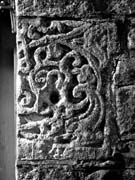Select a site alphabetically from the choices shown in the box below. Alternatively, browse sculptural examples using the Forward/Back buttons.
Chapters for this volume, along with copies of original in-text images, are available here.
Object type: Part of a cross-shaft(?)
Measurements: H. max. 45 cm (17.75 in); W. 30 < 32 cm (c. 12 in); D. 15 cm (6 in)
Stone type: As Chew Stoke 1, but no watermark noted.
Plate numbers in printed volume: Pls. 202-3; Fig. 22c
Corpus volume reference: Vol 7 p. 148
(There may be more views or larger images available for this item. Click on the thumbnail image to view.)
A: A wide flat-band moulding survives on two sides and partly on a third, enclosing a tangled scroll. At the base is a large pointed and curling leaf. Its shape is outlined and it has a subsidiary tendril which almost turns it into a leaf-flower. Its tip passes over the stem of a volute which is filled with curling tendrils and trefoil berry bunches or rounded leaves. Filling the spandrel between the stems on the top right is a large leaf-flower (Cramp 1991, fig. 12 d) with outlined leaves or petals. Curling tendrils on the other sides have been cut off.
B and C: Not visible
D: Plain and recut
I have previously compared this piece with ornament on the Colyton cross and with pieces at Maperton and Littleton Drew (Cramp 1975, 191–3, fig. 19, a, b, e, f; see Ills. 3–4, 304, 455–8), and this is accepted by Plunkett and Foster, as also that there is a particularly close relationship in the plant details to the Colyton cross. On that shaft the panels of different ornament are enclosed in plain flat frames as here, and the plant ornament has large leaves with curling tips and outlined centres, combined with the bell-like leaf-flowers and trefoil berry bunches (Ills. 3–4). Most of these elements are also found in early tenth-century manuscripts such as Cambridge, Corpus Christi College 183, fol. 1v, or fol. 6 (Temple 1976, ills. 18, 29; see Ill. 529) but the long triangular leaf with curled tip is a feature which occurs on earlier crosses such as East Stour (Ill. 63). Moreover, if, as seems likely, both Chew Stoke pieces are from the same monument, then the animal ornament also continues an earlier tradition (see introduction p. 46).



